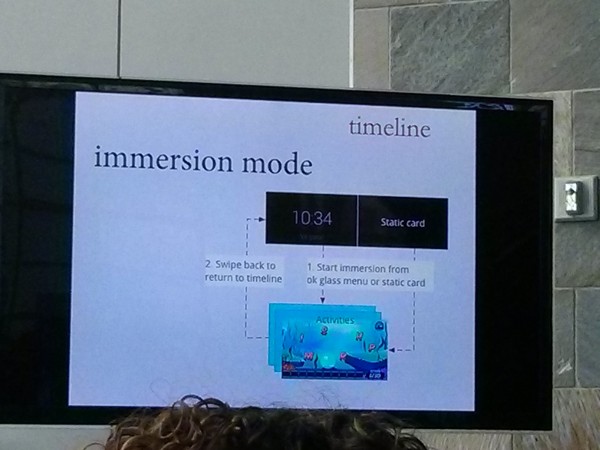Maximiliano Firtman, author of the O’Reilly book, “jQuery Mobile” presented on some basics around development. It was less a look at the development tools and more a look at the options for development and the paradigm you take into account. He’s a a “Google Explorer” and has a chance to muck around with the Glasses for a bit.
Wearable Devices
It’s not the Get Smart phone shoe as a phone. It’s about a variety of tools like Google Glass, Sony Smart Watch, even smart clothes. These tools tend to fulfill multiple purposes. The watch even has a browser.
What Google Glass is and isn’t. It’s not:
- A total science fiction Virtual Reality.
- Not a phone replacement
- Not a projection device
It is:
- It is a location aware device
- It’s limited augmented reality
- It does allow you to take video and pictures
- You can browse the web
- You can use it for maps and directions
- You can share any pictures, video, etc with others via a variety of social tools.
- It has some native apps like translation. Point your glasses at something in English and get the translation to Spanis for example
But About Development
You now have a question, do I create native Google Glass app using Native GDK? Do you use the cloud Mirror API?
There is a web site called MyGlass where you can install apps. Mirror API lets you work directly with a phone via the internet. Any action comes from a server to Google, and then to the glasses.
Most apps have a non-Glass interface to setup preferences. CNN for example lets you define your preferences on what news to receive.
One key difference between Mirror and GDK is that the GDK allows you to go offline.
Timeline
It’s the basic UI of the Glass. It’s past, now, or future. When you turn on glass you are in present. You see the current time.
- Timeline is also the paradigm. To see the past, swipe back on your glasses.
- To see the front, swipe the opposite direction.
Timeline items are known as cards.
- System card- past
- Standard card – past
- Pinned card – future
- Live cards – now

The whole idea of the timeline is to make it easy to get access to information in the correct context of time and location given a limited sized interface and actions you can performs with your gestures.
How do you click in a browser, use a two finger gestures on the side of the glasses and more your head. It works from the user point of view but looks a bit weird from the outside.
Key stats:
- supports html 5 for video, audio, device motion, scroll and touch events
- No geo support in html5 yet.
- Support 400 pixels so small interface of course
- Glasses can be disables remotely
- Google Playground is the official simulator
- Glassim.com lets you see how a picture will look in the real world
- Xenologer for Android on Git hub is the same UI
- Mirror API emulator by Scarygami (on git hub) helps as well
- developer.google.com/glass
- youtube.com/user/GoogleDeveloper – gives you more informations
- Don’t forget you have to make the initial decision on native GDK or app the web based Mirror API
What’s next in wearable?
Possible iWatch from Apple. Other vendors are rumored to be developing glasses